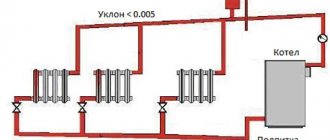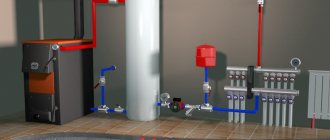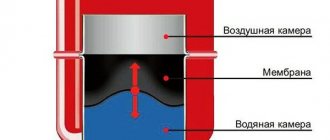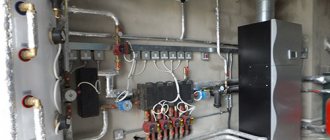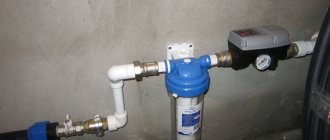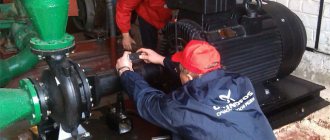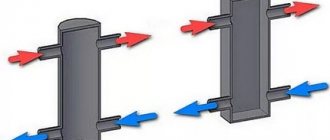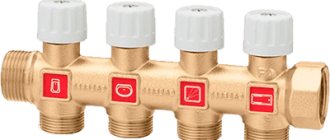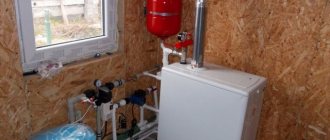Expansion tank
Heating water is designed to transfer heat from the boiler to the radiators. It is known that when heated by 10 °C, the volume of water increases by approximately 0.3%, from which it follows that heating to the required 70 °C will increase the volume by approximately 3% from the original. It is known from a school physics course that liquids are practically incompressible, therefore even such a seemingly insignificant increase in volume can lead to rupture of the pipeline or leaks at the joints. In order to prevent this, an expansion tank is installed in the heating system.
Initially, such containers were open, which led to certain problems:
- — the liquid in them constantly evaporates, you have to monitor the water level and replenish it regularly; — an open expansion tank must be installed in the upper part of the system and insulated to prevent freezing of the coolant and, as a consequence, an increase in the cost of the structure; — constant access of oxygen promotes corrosion; — pressure regulation with an open circuit is difficult.
Modern materials and, in particular, durable and elastic membrane material, make it possible to set up a closed system, without access of oxygen to the coolant. This also allows for a constant water level and the ability to adjust the pressure. Another advantage of a closed container is that it is easy to install and maintain. It can be installed at any point in the heating system and, if necessary, easily dismantled and connected elsewhere.
What is the difference between a hydraulic accumulator for water supply and an expansion tank?
Hydraulic accumulators for water supply or membrane water tanks have been used a lot for a long time. Sometimes the consumer does not even realize that different types of tanks are used for water supply and heating systems. Some illiterate sellers assure buyers that the differences are in the color of the tank. Red tanks for heating are an expansion tank, blue tanks for water supply are a hydraulic accumulator . Is it so? What is the difference between a heating tank and a water supply tank?
Hydraulic accumulator
The main functions that a hydraulic accumulator performs in a water supply system are similar to the functions of an expansion tank in a heating system. First of all, this concerns maintaining sufficient pressure. The most common water supply scheme for a private home includes not only a pump that lifts water from a well or a well, but also a hydraulic accumulator that provides a small supply of water in case of a power outage or pump breakdown.
However, the main task that the hydraulic accumulator solves is to ensure stable pressure regardless of changes in pressure in the system caused by opening the tap or turning the pump on/off. It is selected taking into account the characteristics of the pump, the number of taps, plumbing fixtures and the number of residents. The optimal choice allows you to significantly extend the service life of the pump, because reduces the number of on/off switches. Without a hydraulic accumulator, the pump would turn on every time someone opened the tap for a minute.
The required volume of the hydraulic accumulator can be calculated using the formula
Vt = K * Amax * ((Pmax+1) * (Pmin +1)) / (Pmax - Pmin) * (Pair + 1)
where Amax is the minimum water flow, liter/min; Pmax - pressure at which the pump turns off, bar; Pmin – pressure at which the pump turns on, bar; Pair – pressure in the air chamber, bar;
K – coefficient taken depending on the power of the pump motor
- — for a pump with a power of 0.55–1.5 kW – coefficient 0.25; - 2.2-3.0 kW - 0.375; - 4.0-5.5 kW - 0.625; - 7.5-9.0 kW - 0.875.
The resulting value will be optimal in most cases, however, if there are frequent power outages, it makes sense to choose a larger volume. At the same time, it is worth remembering that if the water is idle for a long time, its quality will deteriorate.
What is a hydraulic accumulator?
For a better understanding, I will immediately show you a picture showing a pumping station:
From the picture you can see that a hydraulic accumulator (abbreviated as HA) is a container to which a pump with a pressure switch is attached. Inside, this container is designed in the same way as a membrane expansion tank. Moreover, they often have exactly the same EPDM membranes. The air pressure in the HA is also 1.5 bar and, if desired, it can be increased or decreased. Many installers use hydraulic accumulators instead of expansion tanks in closed systems. It’s not uncommon to see photos like these on the Internet:
In addition to horizontal GA models, stores have their vertical counterparts. They are most often used to assemble a pumping station based on a deep-well pump. A separate article has been written about the need for this.
Why do you need a hydraulic accumulator?
This “device” has two main functions:
- It is necessary for the correct operation of the pumping station automation. This applies not only to the pressure switch, but also to some pump control units. For this function, the tank volume is not particularly important. For example, miniature pumping stations with a vortex pump have a tank volume of 1 liter.
- Reducing the number of pump starts - this helps reduce the negative impact of starting currents and save energy. For this function, volume is most important. If you need a full-fledged buffer container with water, then you need to choose a capacity of 80, 100 or more liters.
Based on what was written above, we can say that the choice of a hydraulic accumulator is not strictly tied to the parameters of the water supply system. But this does not mean that you need to buy the first one you come across. For example, if your pumping station will operate in conditions of high humidity, then it is better to purchase a hydraulic pump made of stainless steel. This will significantly increase its service life.
That's probably all. I look forward to your questions in the comments and likes on social networks. See you again on the pages of this blog!
znayteplo.ru
Choosing an expansion tank for heating – what to look for?
Before choosing an expansion tank, you should make all the calculations necessary for installation and use. In this case, it is extremely important to take into account the fact that if there is a large amount of coolant, when it is heated, the volume of liquid will increase, and therefore the tank capacity must be large enough, plus have a certain reserve. As a rule, for a one-story house, the best option would be a purchased expansion tank with a capacity of 80 liters. If the heating system used operates in a two-story house, then for its arrangement the volume of the expansion tank should be selected, which is equal to or slightly more than 100 liters. If you need to equip a heating system for a fairly large two-story building, then it is better to choose a tank with a volume of 150 liters.
Another important factor that must be taken into account is the maximum pressure that is created inside the expansion tank. Taking this feature into account, the higher this parameter, the higher the pressure created, which means the smaller the volume the tank can be. Based on this, a tank with a capacity of 50 liters is suitable for a two-story house, and a tank with a volume of 24 liters is suitable for a one-story residential building of medium size.
Calculating the required parameters is quite complex, therefore, when buying a membrane expansion tank, it is best to consult a specialist. In other cases, you can use a special formula. The main quantity in it is the volume of all coolant circulating in the house. Before calculating the main parameter, you will need to calculate the power of the boiler used and all heating devices available in the house. In practice, approximate values are taken at which the radiator power is 10.5 l/kW, the heated floor power is 17 l/kW, and the convector power is 7 l/kW.
Thus, when buying membrane tanks, you should take into account the area of the house and the volume of coolant circulating in its heating system.
Design and purpose of devices
Expansion tank
Both types of devices used in autonomous systems have a similar design and operate on the same principle. Let's look at the main elements of the products using the example of an expansion tank for a heating system:
- The main purpose of the tank is to compensate for the expansion of the coolant. When heated, water increases in volume, and quite strongly (+0.3% for every 10 degrees Celsius). In this case, the liquid practically does not compress, so the heated coolant will exert significant pressure on the walls of the pipes, joints and shut-off valves.
- To compensate for this pressure, as well as to minimize the consequences of water hammer, an additional reservoir is built into the system - an expansion tank. The first tanks were of a leaky design, but today pneumatic-hydraulic models are almost universally used.
- Inside such a tank there is a membrane made of elastic material. Since the membrane is in contact with a heated coolant, it is made from polymers that are resistant to high temperatures - EPDM, SBR, butyl rubber and nitrile rubber.
- The membrane divides the tank into two cavities - the working cavity (the coolant enters it) and the air cavity. As the pressure in the system increases, the air chamber decreases in volume (due to air compression), and this compensates for the load on the pipes and shut-off valves. Approximately the same thing happens with water hammer - but here the process occurs at a faster speed.
- As the temperature of the coolant decreases, the volume of water decreases, and the air, exerting pressure on the membrane, displaces an additional volume of hot water into the pipes of the heating system.
Hydraulic accumulator
The hydraulic accumulator, at first glance, is practically no different in design from the expansion tank:
- The base is the same container made of corrosion-resistant steel, only painted blue.
- There is also a membrane inside the container - although it is slightly different in shape from the membrane of the expansion tank.
- The internal volume is also divided into two chambers, only in hydraulic accumulators the water chamber is located inside the membrane, i.e. Contact of the liquid with the metal walls of the tank is completely eliminated.
And the design functions on a similar principle, although it is used for a different purpose:
- When the pump is turned on or water is supplied through a centralized water supply, the chamber is filled with liquid under a certain pressure.
- If the pressure drops for some reason, the air chamber increases in volume and water from the working chamber enters the system. Thanks to this, the pressure in the pipes is stabilized, and the equipment (washing machines, dishwashers, etc.) works without failures.
- The second aspect of the operation of the hydraulic accumulator is protecting the pump from frequent starts. While it is possible to compensate for the withdrawal of water from the system due to the reserve in the tank, the pressure switch will not operate and the pump will not start pumping water. Thus, the equipment will turn on less often, which means it will work longer.
- A large hydraulic accumulator (50, 100 or more liters) is also a water supply. Yes, you won’t last long on such a supply, but if you use it sparingly, you can easily survive a water supply accident or a power outage that will make the pump impossible to operate.
- In addition, the hydraulic accumulator, like the expansion tank, compensates for water hammer.
